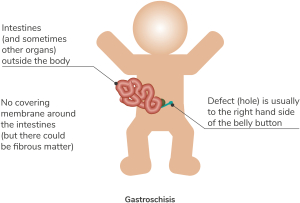Gastroschisis
Gastroschisis is a condition where the baby is born with the intestines outside of the body. It affects about 300 babies in the UK each year, and most of the time is picked up on ultrasound scans before the baby is born. When babies with gastroschisis are born, the bowel will be wrapped up to protect it and to prevent the baby from losing lots of heat and fluid. The baby will also be given antibiotics and fluids into their veins, and the intestines will then be put back inside the baby's tummy. The intestines can either be put inside a plastic tube (called a silo), and then slowly put back inside the tummy over several days, or the baby can undergo an operation to put the intestines back inside all in one go. Both options have their pros and cons, and surgeons will make a decision which option to use based upon what they think is best for an individual baby.

Description of Diagram
In gastroschisis, the intestine, and sometimes other organs protrude out of the baby's body through a hole in the front of the abdomen. This hole is usually to the right of the umbilicus (the belly button). There is no membrane or covering sac around the intestines.
More information about gastroschisis can be found on the websites below:
Avery's Angels are a support group for parents of children born with gastroschisis.

